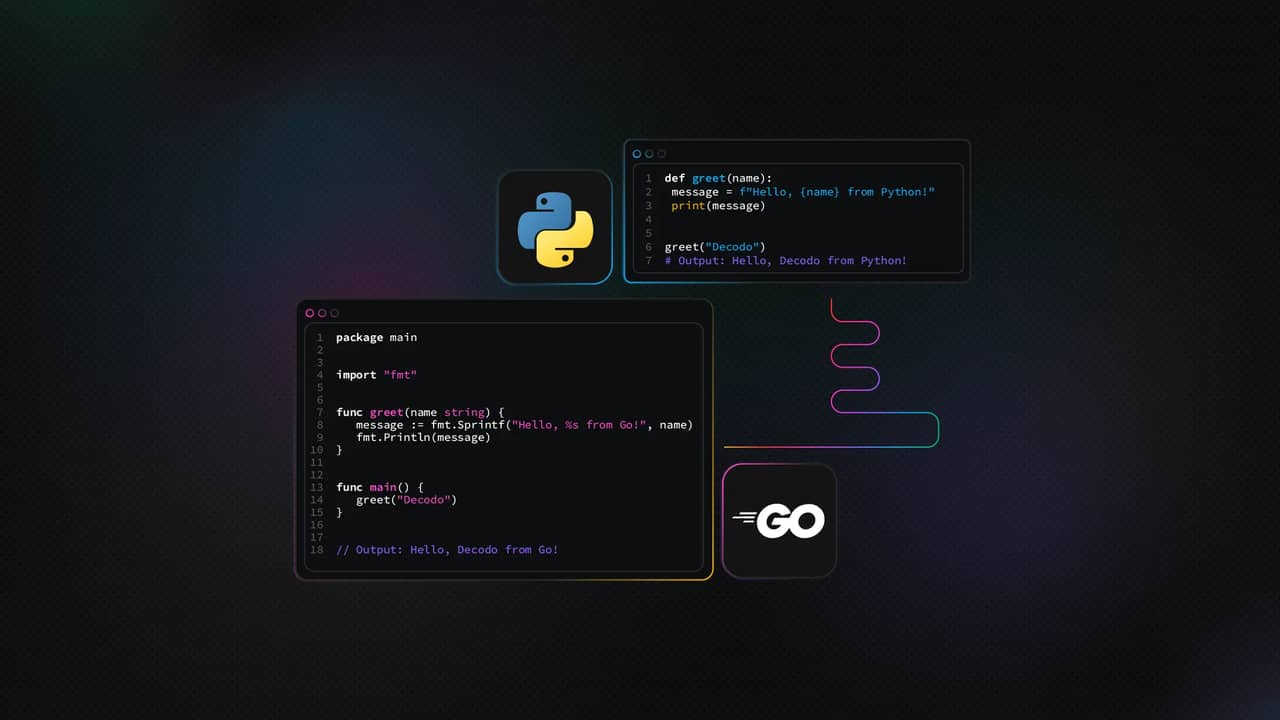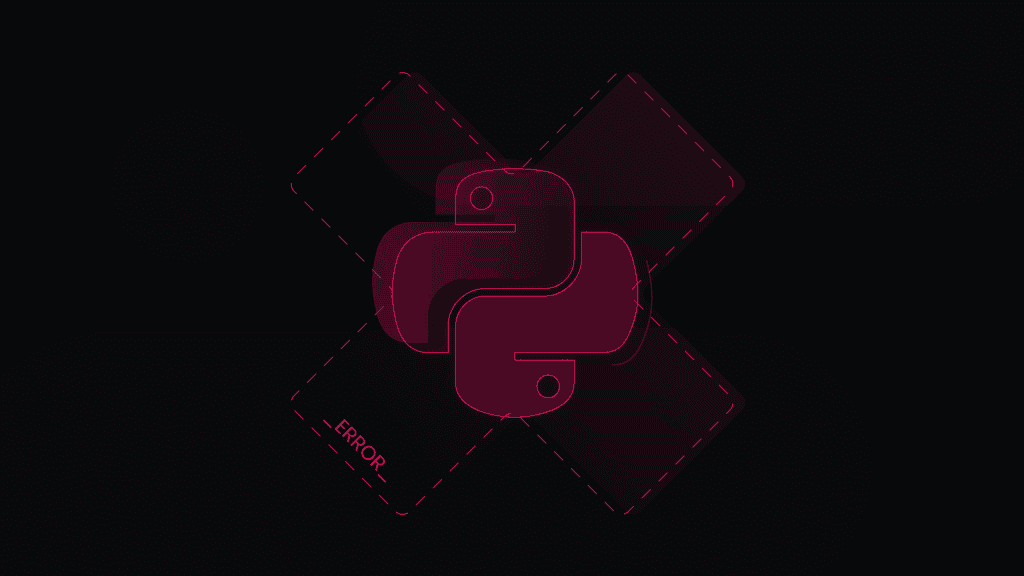Go vs. Python: A 2025 Developer's Guide
The Go vs Python comparison is a key discussion among developers. Go (Golang), created at Google, excels in performance, scalability, and concise syntax for distributed systems. Meanwhile, Python prioritizes readability and rapid development with a vast library ecosystem. Understanding these core differences is crucial for developers choosing tech stacks in 2025 and beyond. Let's dive in!
Justinas Tamasevicius
May 13, 2025
9 min read

Industry perspective and developer trends
Python consistently ranks among the most widely used programming languages worldwide. Surveys like the Stack Overflow Developer Survey (~51% usage) and the JetBrains State of Developer Ecosystem (~57% usage) highlight its widespread adoption across domains. It’s also frequently listed as one of the top languages developers plan to learn.
Go, while less ubiquitous, maintains a solid user base, reported at around 14–18% in the same surveys. It’s often cited as a language developers are planning to adopt or migrate to, with especially strong traction in backend development (a key area in the Go vs Python debate) and cloud-native infrastructure.
Language popularity indices like TIOBE, which measure search engine query volume, regularly rank Python at or near the top (as of May 2025). Go also holds steady in the top 10 (currently ranked 7th), signaling consistent developer interest. Industry data further shows that Go developers often earn competitive salaries, underlining their demand in the market.
What makes Go and Python different
Go and Python fundamentally differ in their design philosophies, syntax, and type systems. When comparing Go vs Python, several key differences stand out.
Basic syntax and design philosophy
Go focuses on simplicity, efficiency, and maintainability, especially crucial for large-scale systems and team collaboration. It uses curly braces {} for code blocks (similar to C/C++) and favors explicitness, making code intentions clear rather than relying on implicit behaviors. A major contributor to its maintainability is gofmt, a tool that automatically enforces a universal code style, thus preventing formatting disputes and ensuring consistency across projects.
This simple example demonstrates Go’s syntax and formatting conventions by defining a greeting function and printing a personalized message: "Hello, Decodo from Go!"
Python, on the other hand, prioritizes developer productivity through high readability. Its clean syntax uses indentation for structure instead of braces, enforcing a consistent visual style across projects. This approach significantly reduces boilerplate, allowing developers to achieve more with less code.
This example showcases Python’s concise and readable syntax by defining and calling a greeting function that outputs: "Hello, Decodo from Python!"
Static vs dynamic typing
Go is statically typed, meaning variable types are checked at compile time, before the program runs. This helps catch type-related errors early in development, leading to more robust code and simpler debugging. When evaluating Go vs Python performance, Go's static typing contributes to its execution speed advantages.
Python, on the other hand, is dynamically typed. Type checking occurs at runtime when the code is executed. This provides significant flexibility, allowing variables to hold values of different types throughout the program's execution, which can speed up initial development and prototyping. However, it can also lead to TypeError or other runtime errors if type mismatches occur unexpectedly, requiring thorough testing or the use of type hints to mitigate these risks.
In a Python vs Go language comparison, Python's dynamic typing offers greater flexibility but potentially at the cost of runtime performance.
Ease of learning
Go is designed with simplicity in mind. It’s relatively easy to learn, especially for those familiar with C-family languages. While features like static typing, explicit error handling, and its concurrency model (Goroutines and Channels) – a key point in the Go vs Python concurrency discussion – may require a bit more effort to grasp, Go’s clean syntax and well-structured standard library help flatten the learning curve.
Python, on the other hand, is often considered one of the easiest programming languages for beginners. Its intuitive, English-like syntax and vast ecosystem of tutorials, documentation, and community support make it highly accessible for new developers.
Performance benchmark: Go vs. Python speed
Performance often plays an important role in language selection, and comparing Go vs Python reveals key differences, especially in execution speed and system resource usage.
Compiled vs. interpreted
Go uses an Ahead-of-Time (AOT) compilation model, translating source code into native machine code. This approach delivers faster execution and reduced runtime overhead. The result is typically a single executable file containing all dependencies, which runs directly on the hardware.
Python, on the other hand, is primarily interpreted. In its standard CPython implementation, code is first compiled into bytecode (.pyc files), which the Python Virtual Machine (PVM) executes line by line. This interpretation layer introduces runtime overhead, particularly in CPU-intensive tasks. While alternative runtimes like PyPy use Just-in-Time (JIT) compilation, they still lag behind the native speed offered by Go.
Real-world benchmark examples
Actual performance depends on hardware, algorithms, and implementation, but benchmark data generally shows Go has a strong edge for CPU-bound tasks and high-concurrency workloads.
Scenario
Task example
Python (CPython) speed
Go speed
Key factors
CPU-bound computation
Numerical simulations, complex logic
Baseline (1×)
10–50× faster
Native machine code vs. bytecode
High concurrency (I/O)
Handling thousands of requests
Higher latency, more overhead
Lightweight, efficient
Goroutines and Scheduler vs. threads/async
API response latency
Simple request/response cycle
~5-20 ms typical
~1-5 ms typical
Low interpreter overhead
Iterative data processing
Looping and transformation
Slower
Faster
Compiled execution, better memory handling
CLI tool startup
Launching a script or tool
~50-150 ms
~5-20 ms
PVM startup vs native binary
Code example – CPU-bound task
Here’s a basic performance comparison loop that shows the overhead difference between compiled and interpreted execution.
Example output (machine dependent): duration: 250.49ms.
Example output (machine dependent): duration: 19.85s.
This specific benchmark highlights interpreter overhead during tight computation loops. In real-world applications, performance also depends on I/O, libraries, and architecture.
Use cases and real-world applications
The characteristics of each language make them suitable for different application domains.
Web development and backend
Go is designed for building high-performance, scalable backend systems – including APIs and microservices. For teams weighing Go vs Python for backend projects, Go offers low latency, high throughput, and built-in concurrency through goroutines. Its standard net/http package and frameworks like Gin, Echo, and Chi provide a lightweight but powerful foundation.
Python, on the other hand, is widely adopted in web development, supported by mature frameworks like Django, Flask, and FastAPI. These frameworks offer robust tools for tasks like ORM, authentication, and content management, accelerating development across a wide range of applications.
When choosing between Python vs Go for web development, Python excels in developer speed and flexibility. However, scaling high-concurrency or CPU-bound workloads in CPython often requires architectural workarounds, such as asyncio-based code, task queues like Celery, or multiprocessing, mainly due to the Global Interpreter Lock (GIL).
DevOps and automation
Go is a cornerstone of the cloud-native ecosystem, powering tools like Kubernetes, Docker, and Terraform. Its ability to compile into static binaries simplifies deployment across diverse environments, making it ideal for building system agents, infrastructure controllers (e.g., Kubernetes Operators), and high-performance CLI tools.
Go’s speed and lightweight concurrency model also make it a strong fit for network services and automation frameworks. Notably, around 75% of projects under the Cloud Native Computing Foundation (CNCF) are written in Go, highlighting its central role in cloud-native infrastructure.
Python, on the other hand, excels at scripting and automation. Its clean syntax and rich library ecosystem allow developers to interact easily with operating systems, cloud APIs (e.g., Boto3 for AWS), and structured data formats. In the Python vs Go landscape for operations, Python is often the go-to choice for quickly building deployment scripts, configuration tools, and system administration utilities.
The trade-off: while Go’s single-binary deployment simplifies distribution, Python applications often require managing dependencies and environments, introducing added complexity when deploying across systems.
Data science and AI
Python is the de facto standard for data science, machine learning (ML), and artificial intelligence (AI). Its dominance comes from a mature, well-supported ecosystem of specialized libraries, including:
- Pandas for flexible data manipulation.
- NumPy for efficient numerical operations.
- Scikit-learn for classical ML algorithms.
- Matplotlib and Seaborn for data visualization.
- TensorFlow and PyTorch for deep learning.
These tools make Python the go-to language for research, prototyping, and experimentation in AI and data science.
In the Go vs Python discussion for AI, Go plays a different role. While it's not commonly used for model development or advanced statistical analysis, due to its less extensive ML ecosystem, it’s gaining traction in MLOps and model deployment. Go is well-suited for several tasks:
- Serving ML models in high-throughput API servers
- Building scalable data processing pipelines
- Supporting backend components of AI systems
In short, Python excels in development and experimentation. Go excels when it comes to deploying and scaling those models reliably in production environments.
Web scraping
Python is one of the most popular languages for web scraping due to its mature and extensive ecosystem, specifically designed for this purpose. Key libraries include Requests (for HTTP), BeautifulSoup and lxml (for HTML/XML parsing), and Scrapy (a full-featured framework). For dynamic content requiring client-side JavaScript execution, libraries like Selenium and Playwright allow browser interaction.
The main advantage is the breadth of these libraries, which simplifies handling various scraping challenges, from static page fetches to complex dynamic content and managing proxies or sessions.
Go, on the other hand, gained considerable traction for web scraping, particularly when performance and efficiency are critical concerns like large-scale data collection. Common libraries include the standard net/http package (for HTTP), colly (a popular scraping framework), and goquery (for HTML parsing with a jQuery-like syntax). For dynamic content, chromedp allows driving Chrome (or other browsers) using the DevTools Protocol to scrape JavaScript-rendered pages.
Go's primary advantage is performance, especially in the fetching phase. Benchmarks often show Go completing URL fetching tasks significantly faster than Python (sometimes twice as fast or more).
That said, modern websites often use advanced anti-bot protections like IP rate-limiting, browser fingerprinting, and CAPTCHAs. While technical workarounds exist, these challenges can consume significant engineering time. For large-scale or complex projects, it’s often more efficient to use commercial web scraping solutions that manage proxies, browser orchestration, and CAPTCHA solving – so you can focus on extracting and analyzing the data instead of building the infrastructure.
Scripting and prototyping
Python is often the default choice for writing quick scripts, utility tools, and rapid prototypes. Its dynamic typing, clean syntax, interactive REPL, and massive library ecosystem let developers go from idea to working code in minimal time.
Go, on the other hand, can also be used for scripting, especially when performance, efficiency, or concurrency is important. For example, Go is well-suited for tasks like checking the status of thousands of URLs in parallel. However, for short-lived or simple scripts, its need for compilation and more verbose syntax can slow down initial development compared to Python.
Concurrency and real-time performance
Handling multiple tasks concurrently is a fundamental requirement for modern software. When comparing Go vs Python concurrency, we see the languages take fundamentally different approaches.
Go was designed with concurrency at its core. It introduces two native concepts:
- Goroutines. Lightweight, independently executing functions managed by the Go runtime (not the operating system). They start with just a few KB of stack space, making it possible to run thousands – or even millions – of Goroutines concurrently on typical hardware.
- Channels. Used to safely communicate and synchronize between Goroutines, following the Go philosophy: "Don’t communicate by sharing memory; share memory by communicating."
Python supports concurrency through several mechanisms, each with its own trade-offs:
- Threading. Uses native OS threads but is limited by the Global Interpreter Lock (GIL) in CPython, which prevents multiple threads from executing Python bytecode in parallel. It's suitable for I/O-bound tasks but not effective for CPU-bound parallelism.
- Asyncio. Enables asynchronous programming with async and await. Ideal for managing large numbers of I/O-bound operations in a single thread. However, it doesn’t enable parallel execution for CPU-bound tasks.
- Multiprocessing. Spawns separate processes to achieve true parallelism. Each process has its own interpreter and memory space, bypassing the GIL. This approach works well for CPU-bound workloads but introduces higher memory usage and more complex inter-process communication.
Suitability for high-concurrency apps
Go’s concurrency model is built-in, lightweight, and consistent, making it the better choice for high-concurrency applications such as scalable APIs, real-time data processing, and network services. It enables massive concurrency with low resource overhead and minimal boilerplate. Python is capable of concurrent execution, particularly for I/O-heavy workloads using asyncio, but CPU-bound parallelism requires workarounds like multiprocessing.
Tooling and ecosystem
The productivity of developers often hinges not just on the language itself, but on the ecosystem of tools, libraries, and workflows that surround it.
IDE and editor support
Both Go and Python enjoy excellent support in modern IDEs and editors. Popular options like Visual Studio Code, GoLand (for Go), and PyCharm (for Python) offer advanced features such as code completion, linting, debugging, refactoring tools, and integrated test runners. This makes working with either language a smooth experience across platforms.
Package ecosystems and maturity
Python has one of the largest and most mature package ecosystems in the world, supported by pip and the Python Package Index (PyPI). Whether you're working on web development, data science, machine learning, automation, or networking, chances are there’s a well-maintained library for your needs.
Go, on the other hand, offers a robust standard library out of the box, particularly strong in areas like networking, concurrency, and JSON handling. Its external package ecosystem, managed via Go Modules (go mod), is smaller but growing steadily, especially in areas like backend systems and infrastructure tooling.
Learning curve and community support
The ease of getting started and the availability of community support are important factors for both individual developers and teams.
Community size and engagement
Python benefits from having one of the largest, oldest, and most diverse programming communities globally. This translates into an abundance of resources, active forums, local meetups, and readily available help for a vast range of problems. Its vast size means you are very likely to find someone who has encountered and solved a problem similar to yours.
Go, on the other hand, has a smaller community compared to Python, but it is highly engaged, rapidly growing, and known for being welcoming and focused, particularly around its core use cases.
Learning resources
Python has a vast volume of learning resources catering to all levels, from absolute beginners to advanced practitioners. Official documentation is good, and countless books, online courses (both free and paid), tutorials, and blog posts cover an extremely wide range of topics.
Go, on the other hand, also offers excellent official documentation (including the highly recommended A Tour of Go), comprehensive tutorials, and a growing number of community-created resources. While the overall quantity might be less than Python's, the quality of official and community resources is generally high and well-maintained.
Which one should you choose?
There’s no universally "better" language – your choice should depend on your specific project needs, team expertise, and long-term goals in 2025 and beyond.
Choose Go if:
- Performance, efficiency, and low resource consumption are critical.
- You’re building high-concurrency systems like scalable APIs, microservices, or network services.
- You want simple deployment via a single, statically linked binary.
- The project involves infrastructure software, CLI tools, or cloud-native components.
- Your team prefers the reliability and clarity of static typing in large codebases.
- You’re operating in domains where Go is widely used (e.g., cloud, DevOps, containerization).
Choose Python if:
- Rapid development, speed to market, and iteration are top priorities.
- The project is focused on data science, machine learning, AI, or statistical computing.
- You need access to a massive ecosystem of mature, domain-specific libraries.
- Your team includes beginners or prioritizes ease of writing and readability.
- You’re building automation scripts, quick utilities, or general-purpose tooling.
Pros and cons summary
Feature
Go
Python
Pros
High performance, native concurrency with Goroutines and Channels, static typing, fast compilation, simple single-binary deployment, efficient memory usage, strong standard library (especially for networking and concurrency).
Easy to learn and read, rapid development, huge and versatile ecosystem (especially for AI/data tasks), active community, ideal for scripting and automation.
Cons
Smaller ecosystem (especially in data/AI), more verbose for simple tasks, steeper learning curve for concepts like static typing and concurrency.
Slower performance (interpreted), GIL limits CPU-bound threading, dynamic typing can cause runtime errors, and higher memory consumption.
Conclusion
Go and Python are both powerful programming languages with distinct design goals and strengths. The decision in 2025 isn't about declaring one language universally "better" than the other. Instead, it's about making an informed choice based on a clear understanding of your project's specific requirements, performance needs, team expertise, and the strengths each language brings to the table.
Analyze your needs, consider the development and operational trade-offs, and potentially experiment with both to determine the best tool for your specific job. In many complex systems, a polyglot approach, leveraging the strengths of both languages for different components, can be an effective strategy.
Try all-in-one Web scraping API
Collect data without a single line of code – start your 7-day free trial with 1K requests.
About the author

Justinas Tamasevicius
Head of Engineering
Justinas Tamaševičius is Head of Engineering with over two decades of expertize in software development. What started as a self-taught passion during his school years has evolved into a distinguished career spanning backend engineering, system architecture, and infrastructure development.
Connect with Justinas via LinkedIn.
All information on Decodo Blog is provided on an as is basis and for informational purposes only. We make no representation and disclaim all liability with respect to your use of any information contained on Decodo Blog or any third-party websites that may belinked therein.

